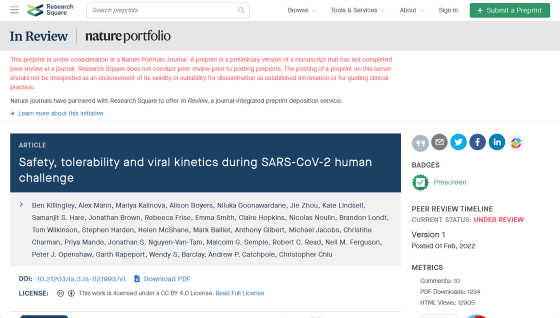Experimental results that healthy people develop COVID-19 with 'new coronavirus for one drop of runny nose'

Even young and healthy people develop a new coronavirus infection (COVID-19) with 'a new coronavirus for one drop of runny nose', which actually injects the new coronavirus into the nose of volunteers. It became clear in the experiment.
Safety, tolerability and viral kinetics during SARS-CoV-2 human challenge | Research Square

COVID-19 human challenge study reveals detailed insights into infection | Imperial News | Imperial College London
https://www.imperial.ac.uk/news/233514/covid-19-human-challenge-study-reveals-detailed/
One nasal droplet's worth of coronavirus is enough to make you sick | Live Science
https://www.livescience.com/coronavirus-challenge-study-preliminary-results
Exposure to one nasal droplet enough for Covid infection – study | Coronavirus | The Guardian
https://www.theguardian.com/world/2022/feb/02/exposure-to-one-nasal-droplet-enough-for-covid-infection-study
A research team in the United Kingdom recruited healthy volunteers aged 18 to 29 years who had not been vaccinated and had no history of infection with the new coronavirus, and conducted an 'experiment to intentionally infect them with the new coronavirus and observe their progress.' In the experiment, a total of 34 subjects were delivered to the nose with droplets containing the new coronavirus strain that was prevalent before the emergence of the alpha, delta, and omicron strains. According to the research team, the amount of new coronavirus contained in this droplet was about the same as one drop of runny nose in a COVID-19 patient who had peaked infectivity.
Volunteers remained in the quarantine unit after the droplets were delivered to the nose and were monitored by doctors 24 hours a day. As a result, 18 out of 34 people were infected with the new coronavirus, and 16 of them had mild to moderate symptoms such as sore throat, headache, myalgia, arthralgia, fatigue, fever, runny nose, sneezing, and loss of smell. I developed. The affected individuals were treated appropriately and none of them became severely ill, but 3 of the 13 who reported loss of olfactory sensation had a complete recovery of olfactory sensation 3 months after the experiment. It is reported that it is not.
According to the research team, the virus was detected or manifested in the infected person's body 'on average 42 hours after the virus's exposure', and the expected average incubation period was '5 to 5 after the virus's exposure'. It was significantly shorter than '6 days'. In addition, the virus was detected in the throat about 40 hours after exposure and in the nose 58 hours after exposure. The viral load in the patient's body peaked 5 days after exposure, but the viral load in the throat was generally lower than in the nose. The results emphasize the importance of face masks that cover both the mouth and nose, the research team said.

'First of all, there were no serious symptoms or clinical concerns for young and healthy subjects in this infection challenge model,' said Professor Christopher Chiu of the Institute of Infectious Diseases at Imperial College London. 'People in this age group are considered to be the main contributors to pandemics. This study represents mild cases of infection and allows us to examine in detail the factors that contribute to infection and pandemic spread.' I will. '
Professor Wendy Berkeley, Dean of the Department of Infectious Diseases at Imperial College London, told The Guardian, a major British newspaper, that 18 infected people had similar viral loads with or without symptoms. Claims that asymptomatic infected individuals may spread the virus. 'Many people are roaming around releasing the virus, and they may not be aware of it,' he said.

by Jernej Furman
This paper was published in Springer Nature 's preprint database, In Review, and has not been peer-reviewed at the time of writing the article. The researchers also point out that the new coronavirus used was a strain that prevailed before the Alpha, Delta, and Omicron strains, and its infectivity may be underestimated.
The research team plans to investigate the reason why some subjects were not infected with the new coronavirus, and to conduct a similar experiment with the Delta strain. 'Mutants such as the Delta and Omicron strains have different infectivity of the virus, but they are basically the same disease, and the same factors provide protection against each,' said Professor Chiu.
Related Posts:
in Science, Posted by log1h_ik







